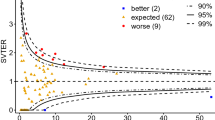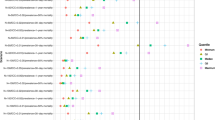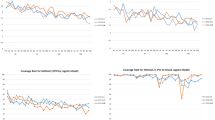Abstract
In this work we propose the use of a graphical diagnostic tool (the funnel plot) to detect outliers among hospitals that treat patients affected by Acute Myocardial Infarction (AMI). We consider an application to data on AMI hospitalizations recorded in the administrative databases of our regional district. The outcome of interest is the in-hospital mortality, a variable indicating if the patient has been discharged dead or alive. We then compare the results obtained by graphical diagnostic tools with those arising from fitting parametric mixed effects models to the same data.






Similar content being viewed by others
Notes
This is a risk index developed by 3M Health Information Systems and it combines the ICD-9-CM codes of Primary diagnosis, Secondary diagnoses and Procedures. Once the clinical model for severity of illness and risk of mortality was developed for each base APR-DRG, it was evaluated with historical data, extensively reviewed and regularly updated.
References
AHRQ QualityIndicators (2007) Guide to inpatient quality indicators: quality of care in hospitals - volume, mortality, and utilization. Department of Health and Human Services Agency for Healthcare Research and Quality, Version 3.1
Austin PC, Naylor CD, Tu JV (2001) A comparison of a Bayesian vs. a frequentist method profiling hospital performance. J Eval Clin Pract 7:35–45
Austin PC, Alter DA, Tu JV (2003) The use of fixed- and random-effects models for classifying hospitals as mortality outliers: a Monte Carlo assessment. Med Dec Making 23:526–539
Barbieri P, Grieco N, Ieva F, Paganoni AM, Secchi P (2010) Exploitation, integration and statistical analysis of Public Health Database and STEMI archive in Lombardia Region. Complex data modeling and computationally intensive statistical methods Series “Contribution to Statistics”. Springer, pp 41–56
Campbell MJ, Jacques RM, Fotheringham J, Maheswaran R, Nicholl J (2012) Developing a summary hospital mortality index: retrospective analysis in English hospitals over five years. Br Med J344:e1001
De Marco MF, Lorenzoni L, Addari P, Nante N (2002) Evaluation of the capacity of the APR-DRG classification system to predict hospital mortality. Epidemiol Prev 26(4):183–190
DerSimonian R, Laird N (1986) Meta-analysis in clinical trials. Control Clin Trials 7:177–188
Egger M, Smith GD, Schneider M, Minder C (1997) Bias in meta-analysis detected by a simple, graphical test. Br Med J 315(7109):629–624
Farrel PJ, Groshen S, MacGibbon B, Tomberlin TJ (2010) Outlier detection for a hierarchical Bayes model in a study of hospital variation in surgical procedures. Stat Methods Med Res 19:601–619
Garbe S, Primer E (2007) Administrative health databases in observational studies of drug effects-advantages and disadvantages. Nat Clin Pract Rheumatol 3:725–732 [review]
Grieco N, Ieva F, Paganoni AM (2012) Performance assessment using mixed effects models: a case study on coronary patient care. IMA J Manag Math 23(2):117–131
Guglielmi A, Ieva F, Paganoni AM, Ruggeri F, Soriano J (2013) Semiparametric Bayesian modeling for the classification of patients with high observed survival probabilities. J R Stat Soc- Ser C. (in press)
Jones HE, Spiegelhalter DJ (2011) The identification of “unusual” health-care providers from a hierarchical model. Am Stat 65(3):154–163
Light RJ, Pillemer DB (1984) Summing up: the science of reviewing research. Harvard University Press, Cambridge
Mohammed MA, Deeks JJ (2008) In the context of performance monitoring, the caterpillar plot should be mothballed in favor of the funnel plot. Ann Thorac Surg 86:348
Normand SLT, Glickman ME, Gatsonis CA (1997) Statistical methods for profiling providers of medical care: issues and applications. J Am Stat Assoc 92:803–814
R Development Core Team (2009) R: a language and environment for statistical computing. R Foundation for Statistical Computing, Vienna [Online]. http://www.R-project.org
Racz J, Sedransk J (2010) Bayesian and frequentist methods for provider profiling using risk-adjusted assessments of medical outcomes. J Am Stat Assoc 105(489):48–58
Romani PS, Chan BK (2000) Risk-adjusting acute myocardial infarction mortality: are APR-DRGs the right tool?Health Serv Res 34(7):1469–1489
Ministero della Sanità (1991) Decreto 28 Dicembre, [online] http://www.trovanorme.salute.gov.it/dettaglioAtto?id=12967&articolo=3
Spiegelhalter DJ (2002) Funnel plots for institutional comparisons (letter). Qual Saf Health Care 11:390–391
Spiegelhalter DJ (2005) Funnel plots for comparing institutional performance. Stat Med 24:1185–1202
Spiegelhalter DJ, Sherlw-Johnson C, Bardsley M, Blunt I, Wood C, Grigg O (2012) Statistical methods for healthcare regulation: rating, screening and surveillance. J R Stat Soc - Ser A 175:1–47
Wirehn AB, Karlsson HM, Cartensen JM et al (2007) Estimating Disease Prevalence using a population-based administrative healthcare database. Scand J Public Health 35:424–431
Van Walraven C, Austin P (2012) Administrative database research has unique characteristics that can risk biased results. J Clin Epidemiol 65:126–131
Acknowledgments
This work is within the Strategic Program “Exploitation, integration and study of current and future health databases in Lombardia for Acute Myocardial Infarction”. The authors wish to thank Regione Lombardia - Healthcare division for having funded and sustained the project, Lombardia Informatica S.p.A. for having provided data and all the physicians who collaborated to STEMI Archive planning and data collection.
Author information
Authors and Affiliations
Corresponding author
Rights and permissions
About this article
Cite this article
Ieva, F., Paganoni, A.M. Detecting and visualizing outliers in provider profiling via funnel plots and mixed effect models. Health Care Manag Sci 18, 166–172 (2015). https://doi.org/10.1007/s10729-013-9264-9
Received:
Accepted:
Published:
Issue Date:
DOI: https://doi.org/10.1007/s10729-013-9264-9
Keywords
- Funnel plots
- Generalized linear mixed models
- In-hospital survival
- Provider profiling
- Acute Myocardial Infarction




